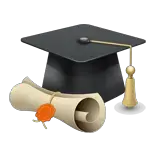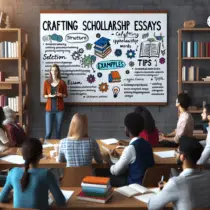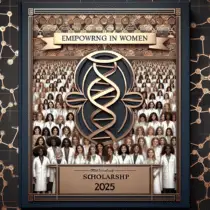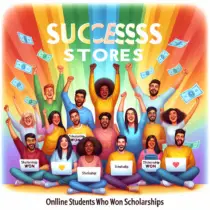Crafting Compelling Scholarship Essays: Tips and Examples
Securing a scholarship can transform a student’s educational journey. One vital component of many scholarship applications is the essay. Writing a compelling scholarship essay can seem daunting, but by breaking down the process and understanding key elements, any student can improve their chances of success. This article explores essential tips for crafting impressive scholarship essays and offers practical examples to illustrate these strategies.
Understanding the Prompt
Before starting the essay, it’s crucial to thoroughly understand the prompt. Scholarship committees design these prompts to gauge various aspects of a candidate’s suitability. Does the prompt ask for a personal story, an explanation of future goals, or a discussion of past achievements? Addressing the specific question asked is the first step in crafting a compelling essay.
Brainstorming Ideas
Once the prompt is clear, brainstorming follows. This stage involves jotting down all potential ideas related to the prompt. Students should think about their achievements, challenges, goals, and moments that have defined their journey. This broad range will help identify the most compelling narrative to share in the essay.
Creating an Outline
After brainstorming, the student should organize their ideas into a coherent outline. An outline ensures that the essay has a logical flow, making it easier for the reader to follow. Common components of an essay outline include the introduction, body paragraphs, and conclusion. Each section has a specific role in making the essay persuasive and engaging.
Writing a Strong Introduction
The introduction is the first impression the reader will have of the essay, so it must capture their attention immediately. An engaging opening can be achieved through a compelling anecdote, a surprising fact, or a thought-provoking question. It should also clearly state the main point or thesis of the essay, setting the stage for the narrative that follows.
Crafting the Body Paragraphs
Body paragraphs should delve into the details of the student’s story or argument. Each paragraph should focus on a single aspect or idea, which supports the overall thesis.
Example of a Body Paragraph:
Maya faced numerous challenges during high school, yet these hardships shaped her resilience and determination. Growing up in a single-parent household, financial constraints often overshadowed academic pursuits. Despite this, Maya secured a part-time job to contribute to household expenses while maintaining a 4.0 GPA. Her dedication extended beyond academics, as she volunteered at the local community center, teaching computer skills to elderly residents. These experiences not only honed her time-management skills but also fostered a deep sense of empathy and community responsibility.
Highlighting Achievements and Goals
A compelling scholarship essay goes beyond listing achievements. It should convey how these accomplishments are relevant to the candidate’s future goals. Clear connections between past experiences and future aspirations demonstrate a well-thought-out plan and a clear sense of purpose.
Example of linking achievements to goals:
John’s passion for environmental science was ignited during a summer internship at a local conservation organization. There, he spearheaded a project that significantly improved water quality in nearby streams. This hands-on experience solidified his desire to pursue a degree in Environmental Studies. Through continued education and research, John aims to develop sustainable water management systems to address global water scarcity challenges.
Be Authentic and Personal
Authenticity is crucial in a scholarship essay. Committees look for genuine reflections rather than what candidates think they want to hear. Personal stories and experiences make the essay unique.
Example of Authenticity:
Growing up as the eldest of five siblings, Lisa learned responsibility at a young age. She often helped her mother, who worked two jobs, by taking care of her younger siblings. These early responsibilities instilled in Lisa a profound sense of discipline and compassion, traits she now channels into her volunteer work at a local homeless shelter. Her personal journey has shaped her aspiration to become a social worker, where she hopes to advocate for underprivileged families.
Addressing Challenges
Many scholarship prompts ask candidates to discuss challenges they have faced and how they overcame them. This part of the essay should highlight resilience and problem-solving abilities. It’s essential to frame challenges as opportunities for growth and learning.
Example of Overcoming Challenges:
During her sophomore year, Sarah was diagnosed with a severe medical condition that required multiple surgeries. The time away from school was academically and emotionally challenging. However, Sarah’s determination saw her catching up with missed work through online classes and tutoring sessions. Her illness heightened her interest in medical research, inspiring her to pursue a career in biomedical engineering. By channeling her personal experience into a future goal, Sarah aims to contribute to developing medical technologies that improve patient outcomes.
Using Clear and Concise Language
Clarity is key in any form of writing, especially in scholarship essays where word limits are often stringent. Students should use clear and concise language to convey their messages effectively. Avoiding jargon and overly complex sentences ensures the essay is accessible and impactful.
Revising and Proofreading
Revision is a critical step in essay writing. Students should take time to review their essays, making sure each part aligns with the prompt and the overall narrative is coherent. Proofreading is equally important to eliminate grammatical errors and improve sentence structure and readability.
Seeking Feedback
Seeking feedback from teachers, mentors, or peers can provide valuable insights. External perspectives can highlight areas that might need more clarity or depth. It’s important, however, to remain true to one’s voice and experiences while incorporating constructive feedback.
Practicing Regularly
Like any skill, essay writing improves with practice. Regular writing helps students find and refine their narrative voice. Practicing with different prompts can also prepare them for any surprises in actual scholarship applications.
Conclusion
Crafting a compelling scholarship essay involves understanding the prompt, brainstorming, outlining, writing, revising, and seeking feedback. It’s about telling a personal story in a way that resonates with the reader and aligns with the scholarship’s goals. By focusing on authenticity, clarity, and connection between past experiences and future aspirations, students can create essays that stand out in a competitive field.
Final Example Essay
Prompt: Describe a significant challenge you have faced and how you overcame it.
Essay:
Growing up in a small rural town, education was not prioritized, and opportunities were scarce. As the first in my family to aspire for higher education, I faced significant resistance and numerous obstacles. My parents, hardworking farmers, believed that my place was to continue the family tradition, not to pursue college.
Determined to change my path, I took on the challenge of balancing farm duties with academic responsibilities. Early mornings began with feeding livestock and milking cows before heading off to school. After returning home, it was back to the farm until dusk. Despite the physical exhaustion, I devoted every spare minute to my studies, often staying up late into the night to complete assignments and prepare for exams.
The turning point came during my junior year when I learned about the state science fair. Determined to prove my capability and shift my parents’ perception, I designed a project on sustainable farming practices, integrating traditional methods with modern technology. The project not only won first place but also caught the attention of a local agricultural scientist who became my mentor.
Through this mentorship, I gained access to resources and was able to participate in advanced research projects. With a renewed perspective, my parents began to support my academic endeavors. By the time I graduated, I was accepted into my dream university’s agricultural engineering program.
Overcoming this challenge taught me resilience, determination, and the power of education. My aspiration now is to continue developing sustainable farming technologies that help small rural farmers improve yields and livelihoods, just as I did for my family. This scholarship will bring me one step closer to achieving that goal and making a lasting impact on rural communities worldwide.
In this example, the essay effectively addresses the prompt by detailing a specific challenge, the steps taken to overcome it, and the resulting personal growth and future goals. It is authentic, clear, and engaging, providing a compelling narrative for the scholarship committee.
In summary, scholarship essays are a critical component of many applications. By understanding the prompt, presenting an authentic personal story, and connecting past experiences to future goals, students can craft compelling essays that significantly enhance their chances of securing scholarships. Regular practice, thorough revision, and seeking feedback are all essential steps in this process, leading to well-written and persuasive essays.






